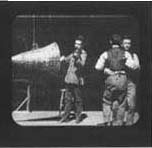
The notion of music in performance-based entertainment is certainly a long one - musical theatre, variety shows, operas, and more. Without tracing out this lengthy history all the way from antiquity, let us for now be satisfied in accepting that music has been an intrinsic part of entertainment for a long time.
It follows, then, that when the first moving picture features began to appear in the late 19th century, that music was typically provided in the theatre by one or more musicians. This accompaniment, which was often solo piano or organ, sometimes also with a group, was at first chosen or even improvised by the performer. But, as film makers began to recognize the great potential for music in their works, they began to exert more control over its selection, even commissioning to have pieces specially written in some cases.
Experiments to unite sound and film started as early as 1895 with the Edison Company, with a short film involving a dance scene with a solo violin in the background. In 1913, the Kinetophone, a box with a peep-hole for viewing the image and two rubber tubes connecting the viewer's ears to phonographs that could play music, was developed. This technology, of course, was primitive and the quality of sound was low, not being able to convey a strong sense of emotion and feeling. Throughout the next few years synchronization of the sound and development of projection equipment enabled viewing in movie houses, thus beginning to create the experience of going to see a movie. In 1927, this experienced was enriched by the integration of spoken word for the first time in the form of broken dialogue, along with a soundtrack of songs, in the motion picture "Jazz Singer". The developing quality of sound, along with the ability to hear conversations and thoughts of characters, marked a significant move towards a very intimate movie experience.
Since then, the exponential advancements in both the quality of sound projection, with inventions such as Stereo in the 1950s, Dolby Surround Sound in the early 1970s, and THX mixing from Lucasfilm in 1983 as a method of assuring a uniformly high level of sound quality in theatres, as well as more sophisticated equipment for synchronization and dynamically layering multiple tracks of music and sound, has allowed for music to operate at a variety of emotive levels.


